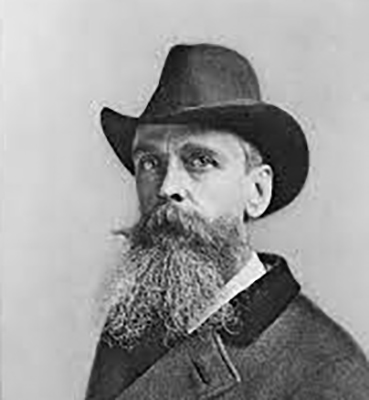THOMAS MORAN (1837-1926)
 Thomas Moran (1837-1926) was born into a working-class family of weavers in Bolton, England. Left behind by the industrialization of the textile industry in the mid 19th century, the family emigrated to Philadelphia in 1844. As a teenager, Moran became an apprentice for the Philadelphia engraving firm of Scattergood and Telfer but left after three years in order to pursue painting. He spent several years training with his older brother, Edward, who was working as a marine painter and developed a lifelong fascination with the work of the English landscape painter J.M.W. Turner.
Thomas Moran (1837-1926) was born into a working-class family of weavers in Bolton, England. Left behind by the industrialization of the textile industry in the mid 19th century, the family emigrated to Philadelphia in 1844. As a teenager, Moran became an apprentice for the Philadelphia engraving firm of Scattergood and Telfer but left after three years in order to pursue painting. He spent several years training with his older brother, Edward, who was working as a marine painter and developed a lifelong fascination with the work of the English landscape painter J.M.W. Turner.
The major turning point in Moran’s career came in 1871 when he accompanied a geological survey of Yellowstone, working closely with photographer William H. Jackson to create paintings that captured the fascinating natural beauty and grandeur of the area. Moran’s paintings of Yellowstone won considerable attention and are credited as helping bring about Yellowstone’s designation as America’s first national park.
During the next few years, Moran accompanied more exhibitions into the American West, journeying to places which included Yosemite, the Grand Canyon, the Colorado River, the Mount of the Holy Cross and creating majestic paintings of the natural beauty that he found there. For the rest of his life, Moran continued to travel widely, creating drawings, etchings, and paintings of what he encountered. Today, Moran is credited as playing a pivotal role in creating the mythology of the American West.
Moran’s canonical work is represented in the permanent collections of the Smithsonian Institution, Washington D.C.; National Gallery of Art, Washington D.C.; Metropolitan Museum of Art, New York; Philadelphia Museum of Art, Philadelphia; Art Institute of Chicago; Chicago; Brooklyn Museum, New York; Museum of Fine Arts, Boston; and the White House Collection, Washington, D.C. among many others.
